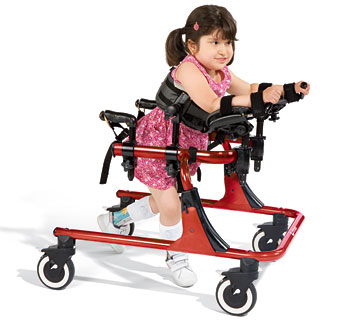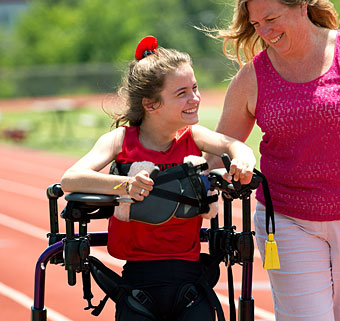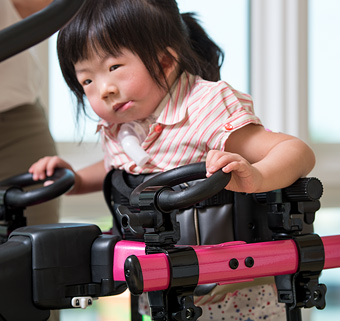Making Better Use of Arm Supports
| August 2016Adaptive gait devices come with a wide range of positioning accessories for supporting upright and ambulatory postures. Of these, arm supports are frequently used to provide basic upper extremity placement and positioning. But when understood and used correctly, arm supports can do so much more, particularly when it comes to positioning in gait. Here they can assist with weight-bearing, stepping, head control and preparing to advance to a less supportive walker.
Weight-Bearing and Stepping with Supported Arms
For step-taking to occur, a person must be able to shift body weight from one leg to the other to allow the alternate limb to advance. This takes well-balanced and controlled muscular efforts. Often people with disabilities present with weak and uncoordinated muscles of the hips and lower extremities making this weight-shift and stepping difficult. With correctly positioned arm supports, however, the shoulder girdle can be

prompted to support some of the body weight and facilitate the step-taking. In the early stages of learning, the forearm prompts should be positioned in a way that allows the user to lean slightly forward with arms staying close to the side of the body. A general rule of thumb is to position the elbows either directly under the shoulder or slightly forward of the shoulder. This positioning stabilizes the shoulder girdle and the user can now bear down through their arms to take some of the weight off the lower extremities.
To better understand this, the next time you’re at the grocery store try this: get a shopping cart, place your forearms on the push handle and lean onto it. Take a few steps and see how easy it feels!

Head control and Arm Positioning
For someone with low tone, arm supports are particularly helpful in assisting with head control. For best outcomes, angle the arm supports upward and position them in front while still maintaining the elbows close to the body. This is effective as it provides stability of the shoulder girdle and cues the supporting neck musculature to function.

A Common Mistake
With arm positioning a common mistake is the “chicken wing” posture. Avoid it! This is when the arms are positioned high and out to the side of the body. It is not an effective position for weight-bearing, and can often result in sagging of the trunk and body in the gait device.
Weaning off the Arm Supports
According to motor learning theory and evidenced by the activity-based therapy approach, when individuals with disabilities get plenty of opportunity to practice a skill such as walking, improvement and learning happens and the person advances to the next level of difficulty.  With a gait trainer this happens through adjusting or reducing the prompts and accessories. Arm supports are often the last accessory to be removed because of their value in promoting efficient weight-bearing and stepping and allowing the patient to “drive” the gait device. Before being taken off however, a great transitional posture is angling the arm supports down. This is excellent for prompting weight-bearing on the hands to prepare for advancement to a Kaye walker or to walk holding onto furniture. For some kiddos (especially those with high tone), it may be a better position for gaining stability and head control.
With a gait trainer this happens through adjusting or reducing the prompts and accessories. Arm supports are often the last accessory to be removed because of their value in promoting efficient weight-bearing and stepping and allowing the patient to “drive” the gait device. Before being taken off however, a great transitional posture is angling the arm supports down. This is excellent for prompting weight-bearing on the hands to prepare for advancement to a Kaye walker or to walk holding onto furniture. For some kiddos (especially those with high tone), it may be a better position for gaining stability and head control.




